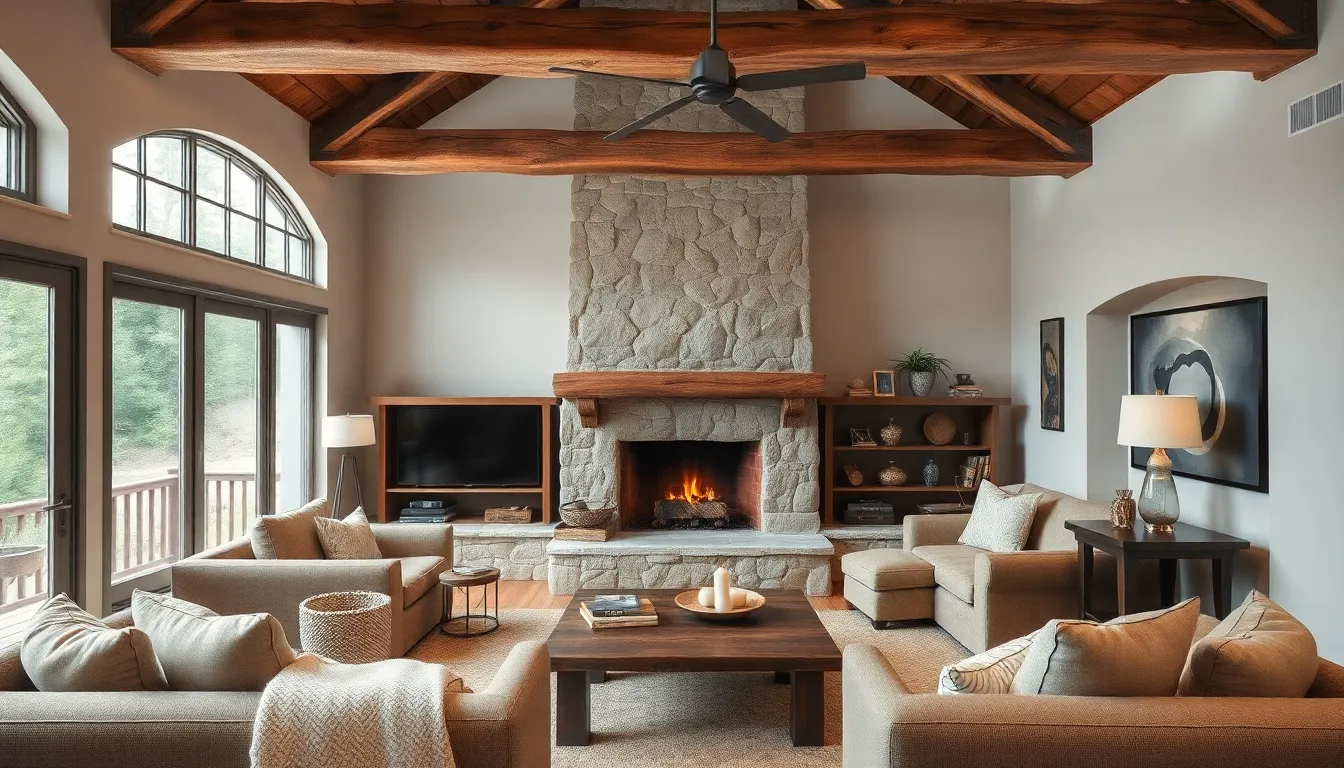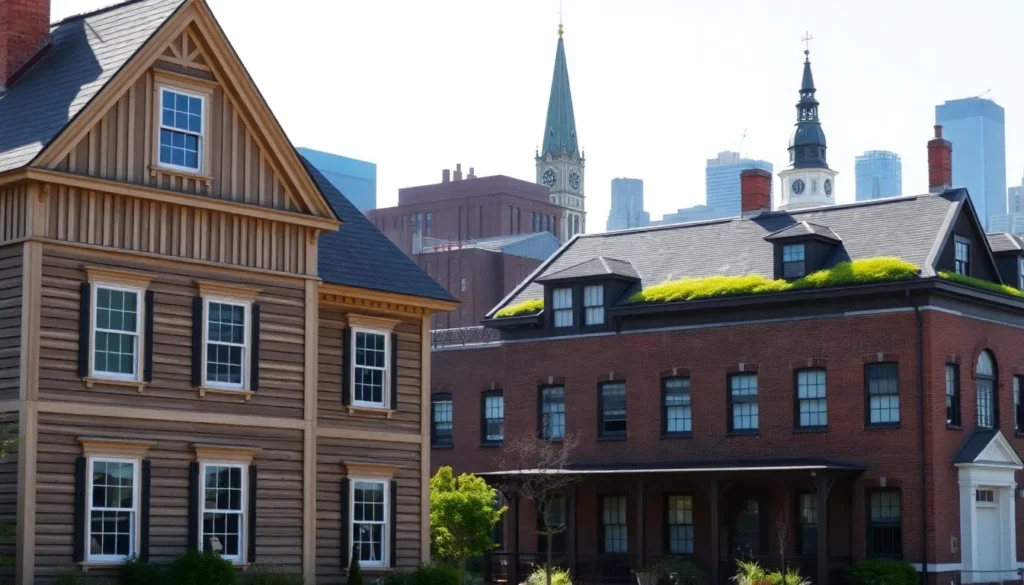Table of Contents
ToggleRustic home design captures the essence of nature and simplicity, creating warm and inviting spaces that feel both timeless and comforting. With its roots in traditional craftsmanship, this style emphasizes natural materials, earthy tones, and a connection to the outdoors. From reclaimed wood beams to stone fireplaces, every element tells a story, inviting homeowners to embrace a lifestyle that values authenticity.
In a world dominated by sleek modern aesthetics, rustic design offers a refreshing alternative that celebrates imperfections and the beauty of the natural world. It’s not just about decor; it’s about creating a sanctuary that reflects personal values and a love for the environment. Whether it’s a cozy cabin in the woods or a charming farmhouse, rustic home design brings a sense of peace and harmony, making it a popular choice for those seeking comfort and character in their living spaces.
Understanding Rustic Home Design
Rustic home design centers on embracing natural elements, simplicity, and warmth. It combines organic materials with a welcoming atmosphere to create spaces that feel immersive and grounded.
Defining Rustic Aesthetics
Rustic aesthetics incorporate features like exposed beams, stone walls, and reclaimed wood. These elements create a raw, unrefined look. Color palettes often include earthy tones, such as browns, greens, and creams. Textures vary, with combinations of rough and smooth surfaces. Furnishings typically include handcrafted or vintage items, enhancing the overall charm. Common patterns include plaid and floral prints, which add a cozy touch. This design celebrates individuality by prioritizing function alongside beauty.
Historical Background of Rustic Design
Rustic design draws inspiration from traditional architecture rooted in rural settings. Its origins link back to early settlers who utilized local materials for practical living. Historical styles include log cabins, farmhouses, and cottages. These structures exemplify craftsmanship and resourcefulness. Over time, rustic design evolved, merging with Arts and Crafts movements that emphasized handmade details. This evolution maintained the focus on nature and authenticity, continuing to inspire contemporary interpretations. The enduring popularity of rustic design reflects a collective preference for simplicity, comfort, and a slower pace of life.
Key Elements of Rustic Home Design

Rustic home design incorporates fundamental elements that evoke warmth and a connection to nature. Key components include natural materials and carefully selected color palettes.
Natural Materials
Natural materials form the backbone of rustic home design. Wood, stone, and metal serve as primary materials, promoting an authentic feel.
- Wood Types: Reclaimed wood, barn wood, and unfinished lumber create character and showcase uniqueness.
- Stone Varieties: Fieldstone, river rock, and slate provide a grounded, raw aesthetic.
- Metal Accents: Wrought iron and aged steel enhance functionality while maintaining a rustic charm.
These materials often highlight imperfections, celebrating the beauty in nature’s inconsistencies. The use of local resources fosters a sense of place and history, reinforcing the rustic theme.
Color Palettes
Color palettes in rustic design prioritize earthy tones that reflect the surrounding landscape.
- Neutral Shades: Warm whites, taupes, and browns create a soothing atmosphere.
- Accent Colors: Deep greens, rust reds, and burnt oranges add vibrancy while maintaining an organic feel.
- Natural Finishes: Textured or matte finishes avoid high gloss, preserving a raw, authentic appearance.
These colors blend seamlessly, establishing a harmonious environment that emphasizes simplicity and comfort. Rustic designs aim to evoke a sense of tranquility, inviting occupants to relax and reconnect with nature.
Popular Rustic Home Design Styles
Rustic home design encompasses various styles that highlight simplicity, warmth, and a strong connection to nature. Key styles include modern farmhouse and cabin and lodge styles, each offering unique characteristics that embody rustic charm.
Modern Farmhouse
Modern farmhouse design blends traditional elements with contemporary touches, creating a comfortable and inviting atmosphere. This style emphasizes open floor plans, large porches, and ample natural light. Key features include:
- Exposed Beams: Wooden beams, often painted white or left natural, add structural interest and a cozy feel.
- Shiplap Walls: This paneling technique brings texture and warmth, frequently painted in soft, inviting colors.
- Vintage Finishes: Use of reclaimed wood, metal fixtures, and antique accents imparts authenticity, bridging past and present.
- Neutral Palettes: Earthy tones mixed with whites and grays establish a serene backdrop, allowing natural elements to shine.
Modern farmhouse design embraces functionality while celebrating rustic aesthetics, fostering spaces that are both practical and stylish.
Cabin and Lodge Styles
Cabin and lodge styles celebrate the outdoors with designs that evoke a sense of retreat and tranquility. Often located in woodland or mountainous areas, these homes incorporate a variety of natural materials. Distinctive elements include:
- Log Construction: Thick logs, used for walls, highlight craftsmanship and create a rustic atmosphere.
- Stone Fireplaces: Stone features serve as focal points, enhancing warmth and comfort in living spaces.
- Natural Textiles: Fabrics like wool, burlap, and canvas introduce comfort while echoing nature.
- Large Windows: Emphasize views of the surrounding landscape, blending the indoors with the outdoors.
Cabin and lodge styles draw inspiration from natural surroundings, creating inviting spaces ideal for relaxation and connection with nature.
Benefits of Rustic Home Design
Rustic home design offers numerous advantages that resonate with those seeking comfort, authenticity, and a deep connection to the natural world. This style embraces elements that create a unique living experience.
Connection to Nature
Rustic home design fosters a strong connection to nature through its emphasis on natural materials and outdoor elements. The use of local stone, wood, and metal allows spaces to blend seamlessly with their surroundings. Large windows enhance natural light and provide unobstructed views of the landscape, inviting the outdoors inside. This integration encourages a sense of tranquility and promotes mental well-being, reflecting the calming effects of nature in everyday life.
Warm and Inviting Atmosphere
Rustic design creates a warm and inviting atmosphere that draws people in. The combination of earthy tones, textured materials, and handcrafted furnishings fosters a cozy environment. Elements like exposed beams and stone walls add character, while soft textiles provide comfort. This atmosphere encourages social interaction and relaxation, making spaces ideal for gatherings and family bonding. The attention to detail and authenticity in rustic design ensures that each home carries a unique personality, making every space feel personalized and welcoming.
Tips for Achieving Rustic Home Design
Achieving rustic home design involves careful selection of furniture and decoration that reflect warmth and authenticity. These tips provide practical guidance on making a rustic space inviting and cohesive.
Furniture Choices
- Opt for Natural Materials: Choose furniture made from wood, leather, or wrought iron. These materials enhance the rustic vibe and promote longevity.
- Incorporate Reclaimed Pieces: Select reclaimed wood furniture to add character. Each piece carries history, contributing to the overall charm of the home.
- Include Vintage Finds: Look for vintage or antique items. Distressed finishes and aged surfaces complement rustic aesthetics beautifully.
- Prioritize Comfort: Choose comfortable seating like oversized sofas or plush armchairs. Soft, inviting furniture encourages relaxation and social gatherings.
- Use Functional Elements: Choose furniture that serves multiple purposes, such as storage ottomans or coffee tables with shelves. These features maintain organization while emphasizing the rustic theme.
Decoration Ideas
- Embrace Earthy Colors: Use color palettes that feature warm neutrals, deep greens, and soft browns. These shades create a soothing atmosphere reflective of nature.
- Add Natural Textiles: Incorporate textiles made from cotton, linen, or wool. Use these in throws, area rugs, and curtains to enhance warmth and comfort.
- Incorporate Natural Elements: Use decor items like stone vases, wooden bowls, or live plants. These additions reinforce a connection to nature and add organic beauty.
- Display Artisan Crafts: Showcase handmade items like pottery or woven baskets. These crafts add uniqueness and support local artisans.
- Utilize Artwork: Hang landscape paintings, photographs of nature, or rustic-themed wall art. Art contributes personalization and enhances the rustic aesthetic.
- Create Cozy Layers: Layer textiles through cushions and throws. This layering adds visual interest while making the space more inviting.
Implementing these furniture choices and decoration ideas cultivates a rustic home that feels both authentic and comforting.
Rustic home design offers a unique blend of comfort and character that resonates with many. By embracing natural materials and earthy tones, it creates inviting spaces that foster a connection to the outdoors. This style not only reflects personal values but also celebrates the beauty of imperfection, making each home a true reflection of its inhabitants.
Whether one opts for a modern farmhouse or a cozy cabin, the essence of rustic design lies in its ability to evoke tranquility and warmth. With thoughtful choices in materials and decor, anyone can transform their space into a rustic retreat that promotes relaxation and well-being. Embracing this design philosophy allows individuals to create homes that are not just aesthetically pleasing but also deeply personal and inviting.


